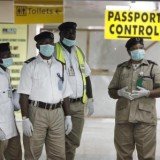“The Hold Terrorgraphs Have Over Us”
 Two different locations, two innocent men, two different reactions to their inevitable demise, one cold-hearted-killer and one certain fate—death. These two victims shown above are headless and mutilated and were ultimately just pawns ISIS used to deliver a political statement to the international community. These “terrorgraphs,” or images and videos that capture the beheading of people in the most inhumane ways, are made to simultaneously instill fear, despair, and a sense of insecurity into the viewer. These images are made to be the “headlines” on Al-Jazeera and CNN, and are used to carry a potent message—“We are coming for you and this is how you will die.” One of the deadliest terror groups present today, ISIS: Islamic State of Iraq and Syria, has claimed responsibility for both of the aforementioned killings and have internet videos that show their members committing similar heinous acts. These two frames that I will use throughout my essay, depicts two men about to be killed by ISIS in two different locations; Libya and Iraq respectively. In the first picture obtained from Conflict News’ Twitter, the man shown praying is one of 21 Egyptian Coptic Christians that were about to be killed by ISIS in Libya in early February. He appears to be making peace with his impending death and is waiting to be martyred. The second image, obtained from an online site Bestgore.com, shows an Iraqi Government soldier being beheaded in broad daylight in Fallujah, a pro ISIS settlement in Iraq. People have surrounded the masked ISIS militant and his prey, appearing to be quite amused at the imminent death of the soldier. Some are even taking pictures and videos with their phones.
Two different locations, two innocent men, two different reactions to their inevitable demise, one cold-hearted-killer and one certain fate—death. These two victims shown above are headless and mutilated and were ultimately just pawns ISIS used to deliver a political statement to the international community. These “terrorgraphs,” or images and videos that capture the beheading of people in the most inhumane ways, are made to simultaneously instill fear, despair, and a sense of insecurity into the viewer. These images are made to be the “headlines” on Al-Jazeera and CNN, and are used to carry a potent message—“We are coming for you and this is how you will die.” One of the deadliest terror groups present today, ISIS: Islamic State of Iraq and Syria, has claimed responsibility for both of the aforementioned killings and have internet videos that show their members committing similar heinous acts. These two frames that I will use throughout my essay, depicts two men about to be killed by ISIS in two different locations; Libya and Iraq respectively. In the first picture obtained from Conflict News’ Twitter, the man shown praying is one of 21 Egyptian Coptic Christians that were about to be killed by ISIS in Libya in early February. He appears to be making peace with his impending death and is waiting to be martyred. The second image, obtained from an online site Bestgore.com, shows an Iraqi Government soldier being beheaded in broad daylight in Fallujah, a pro ISIS settlement in Iraq. People have surrounded the masked ISIS militant and his prey, appearing to be quite amused at the imminent death of the soldier. Some are even taking pictures and videos with their phones.
ISIS and Terrorgraphs
ISIS, the organization responsible for their deaths, is an organized terror group that has bases in Syria, Iraq, the Sinai Desert, and newly added Libya. They are an Islamic extremist sect that believe Islam should be the only practiced religion in the world, and as such, all other religions are enemies that need to be destroyed. Their members are generally extremely affluent and educated, their operations are mostly funded by the oil wells that they control in Iraq and Syria. They usually post images and videos of beheadings of journalists and foreigners they manage to capture and brutally mutilate these people on camera to get the world’s attention. This practice has become very rampant and popular with terror groups such as ISIS and Al-Qaeda but have we ever asked ourselves why it has become so popular? Have terror groups realized something that most of us have not? Clearly, there is a disconnect between us and these killers: How have photographs and videos become an additional weapon to these extremist groups’ arsenal?
Effects of Terrorgraphs on us
We have become so conditioned to hearing of wars, accidents, and other tragedies in such a causal manner that we have become numb to the emotions and shock it is supposed to create in our respective communities. Literary theorist, Geoffrey Hartman’s commentary on viewing images repeatedly in his piece “The Longest Shadow: In the Aftermath of the Holocaust,” poses a very important question that is crucial to this discussion, “Is our capacity for sympathy finite and soon exhausted?” Hartman extrapolates, “The surfeit of violent imagery that constitutes our present visual landscape, has desensitized us to horror”. His hypothesis is that our repeated exposure to harmful images has robbed us of the emotions we would have otherwise shown towards horrific images. Marianne Hirsch, author of “Surviving Images: Holocaust Photographs and the Work of Postmemory,” also agrees that there is a tendency for one to grow accustomed to seeing horrible images which ultimately renders one incapable of realizing the real implications they contain regarding the lives of others. She emphasizes this point in her article by illustrating how two young future critics of Holocaust photography; Alice Kaplan and Susan Sontag respectively, reacted to seeing images of the holocaust in their childhood . They both were shocked and petrified but Hirsch states that this shock was mostly due to the fact that they were young for as they grew older and saw these images over and over again, they became used to seeing them, thus, “Photographs shock insofar as they show something novel…”.
Indeed, people see tragic images as distant fables rather than as tragedies that must evoke feelings of sadness. The only way to get through this societal haze is to do something so outrageous that will leave everyone utterly astounded. These extremists understand this, and that is why they kill people in dehumanizing ways—in order to elicit a reaction. We live in a “society of spectacle” —as Susan Sontag, renowned writer and critic of photography states in her article “Looking at War”—a society that only reacts to the extraordinary and nothing else. We live in a world that has become so self-centered and obsessed with taking images in order to get affirmation and popularity. Communal identity and responsibility has been virtually replaced by selfishness and individuality. This change in societal structure has made us vulnerable to external attack, we are like gasoline ready to be ignited. All that is left for terror groups to do is to light the flame and exacerbate confusion in an already divided society.
In what way should we react to these terrible images? Once the barrier has been broken and the shock factor kicks in, how are we to receive these pictures? Usually, they produce a unified reaction: disgust. There is something horrible in seeing a human being slaughtered like an animal that no matter what cultural or political sect to which one belongs, one would feel violated and distraught viewing these atrocities. Despite this universal disgust, some people still find entertainment in these atrocities; especially people who live close to where these events occur. The Iraqi soldier in the grips of the ISIS militant was in great distress while the people around him in the frame were smiling and eager to capture his death on camera. It did not occur to any of them to help him or alleviate the fragile situation. One of the figures captured in the photograph appears to be an adolescent boy and the smirk on his face really epitomizes the sheer excitement the crowd felt about the impending murder. They were killing the soldier with shame and their camera shutter sounds before he was actually beheaded. Hirsch echoes this sense of ‘camera killing’ before real murder in her article by saying, “The victims are shot before they are shot”. This word play highlights the “double-death” that both the soldier and Copt went through; death of soul and character through the camera and eventual death by physical killing.
This scene sparked a question that kept resounding in my head, what is pushing all these bystanders to capture this image instead of helping the victim? Given the situation, people sometimes tend to take delight in the misfortune of others; especially if it is one’s enemy, and it only takes continuous exposure to tragedies such as bombings and killings to make one immune to compassion and sympathy. The soldier, not ISIS, was the enemy of the people of Fallujah, and this explains why they were delighted to see his death. Schadenfreude, or taking joy in pain of the others, easily develops in areas plagued by wars. The adolescent boy has seen so many deaths of his friends and family that he views the killing of the Iraqi soldier as revenge and progress despite it being a bloody and terrible sight. It might not have been such a horrid spectacle to him and the others in the image because they see these kinds of beheadings on a daily basis, it was just another one, but on this occasion it was not one of their own dying.
Those of us that live far from the proximity of these horrible events, tend to just comment and make hashtags about them. In the end, does that bear any fruit? Take for example the Bring Back Our Girls campaign that was spearheaded by the first lady of the United States, Michelle Obama, and other Hollywood celebrities. The adamant proponents of this movement live far from the destruction and abduction of adolescent girls that went on in northern Nigeria by terror group Boko Haram. This tendency to make hashtags about societal issues is the only way a self-obsessed society such as ours knows how to react. Most of the people involved in the campaign had little knowledge about the situation in Nigeria and were just adding their voices to the movement, naively thinking that Boko Haram would be moved by “tweets” and “posts”. This is just like a having a chained Rottweiler bark at you from inside its owners high walled estate, since the dog has not been released to chase you, you feel no sense of urgency or need to flee. Boko Haram, as expected, did not listen to the demands on social media and continued to keep the girls they had captured. Many have been raped while others were given to members as wives. Very few have escaped until now. Furthermore, just seven days after this New Year’s celebrations, Boko Haram killed over 2000 civilians in the Nigerian town of Baga. The town is now virtually non-existent and in the first week of March, the leader of the group, Abubakar Shekau pledged allegiance to ISIS; they were expediently accepted. Clearly, our inability to act earlier in a more pragmatic way has worsened the situation in Nigeria. When will we finally come out of this illusion of virtual protection to see that these terror groups are actually making great strides towards their agenda? Will it be only when we are attacked? Through the creating of hashtags, we are only contributing to the goals of these organizations. Perhaps, the only way to prevent these events from recurring is to attack and instill fear in those who create fear.
Terrorgraphs as a journalistic tool?
The biggest problem we face as a society is where to draw the line between these terrorgraphs as art, as journalistic tools, and as day-to-day ways of capturing our lives. The invention of smartphones, digital cameras and so on has made everyone a celebrity and a journalist. We “do it for the Vine” and “take selfies” of almost everything without living in the moment. We are thus being forced to outdo each other to get attention. Within seconds we can transmit images from all Honolulu to Moscow. Privacy has ceased to exist. Terrorgraphs and images of an explicit nature are now easily accessible. Sontag’s shrewd assertion that “It seems that the appetite for pictures showing bodies in pain is almost as keen as the desire for ones that show bodies naked,” suggests both pornography and terrorgraphs to be equally potent and destructive. Society now feeds on sex and sexual references while it unconsciously feeds on pain and terror. This has given terror groups an unprecedented level of power and ability to sway public opinion than ever before. Some societies, especially impoverished Muslim societies, even see these militants as heroes. American journalist, Tom Junod, shares a slightly different view about images of terror in his new introduction, “The Fallen Man.” He claims that horrible images like terrorgraphs become iconic after some time and define an era. He cites Associated Press photo-journalist Richard Drew’s photo of the falling man from the World Trade Center as a perfect example of an image that has helped to define the 9/11 period and further claims that the image in the New York Post of journalist James Foley’s beheading will follow suit. Though this might be true, I find these images to be of a personal nature and thus, believe that it would be better if they are kept from the public. Looking at these images to me is like looking at pornography. It serves as an outlet for our unconscious desire to see pain in a similar way that pornography serves as an outlet for our sexual desires. The Image of the Egyptian Copt praying may, in the following years, define the ISIS-Egyptian conflict, but before that happens, terror groups will thrive on the publicity that these images provoke. It is for this reason that I fundamentally disagree with Junod. 9/11 helped to change the United States’ security policies and the images can be used to remember that there was a gap in National Security that was exposed but this cannot be said about the ISIS and Boko Haram terrorgraphs. Until we deal with these groups, I do not see any merit in publishing these images because they just emphasize our vulnerability and empower the oppressor.
Conclusion
Our society needs to reevaluate its obsession with living behind the camera because it makes us lose our ability to sympathize with real life casualties and makes us see these events as times to pull out a camera and start recording. Society’s obsession with megalomania is also causing people to do incredibly dangerous and questionable things just to gain fame and attention. This atmosphere gives terror groups so much power over us. Until we find a way to react constructively to these “terrorgraphs”, they shall give us intermittent shocks that show we have real lives and that death is not so far from the virtual walls we have erected.



















